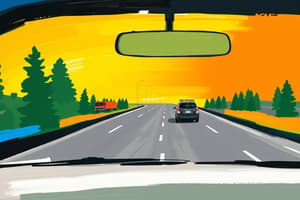Podcast
Questions and Answers
What is the primary purpose of shoulder checking before changing lanes?
What is the primary purpose of shoulder checking before changing lanes?
- To check blind spots not visible in mirrors. (correct)
- To assess the speed of approaching vehicles.
- To adjust your mirrors for optimal visibility.
- To signal your intention to other drivers.
How should a driver respond to a flashing yellow traffic light?
How should a driver respond to a flashing yellow traffic light?
- Stop and proceed only when safe.
- Yield to oncoming traffic, then proceed.
- Maintain speed and continue through the intersection.
- Proceed with caution. (correct)
In what situations is it legally permissible to exceed the posted speed limit?
In what situations is it legally permissible to exceed the posted speed limit?
- During daylight hours for increased visibility.
- When directed by a police officer. (correct)
- When passing another vehicle on a two-lane highway.
- To keep up with the flow of traffic.
What does a solid yellow line on your side of a two-lane road indicate?
What does a solid yellow line on your side of a two-lane road indicate?
What is the recommended action if your tires lose traction and you begin to skid?
What is the recommended action if your tires lose traction and you begin to skid?
When are you required to use your headlights?
When are you required to use your headlights?
What is the safest procedure when approaching a railway crossing with flashing lights and/or a lowered gate?
What is the safest procedure when approaching a railway crossing with flashing lights and/or a lowered gate?
What should you do if you are being tailgated by another vehicle?
What should you do if you are being tailgated by another vehicle?
Under what circumstances are you permitted to drive in a designated high-occupancy vehicle (HOV) lane?
Under what circumstances are you permitted to drive in a designated high-occupancy vehicle (HOV) lane?
What is the appropriate action to take when approaching a school bus with its red lights flashing?
What is the appropriate action to take when approaching a school bus with its red lights flashing?
How does drinking alcohol affect your ability to drive safely?
How does drinking alcohol affect your ability to drive safely?
What is the meaning of a broken white line on a roadway?
What is the meaning of a broken white line on a roadway?
When approaching an intersection with a non-operational traffic signal, what right-of-way rules apply?
When approaching an intersection with a non-operational traffic signal, what right-of-way rules apply?
What is the recommended following distance under ideal driving conditions?
What is the recommended following distance under ideal driving conditions?
What is the appropriate response to an emergency vehicle approaching with its sirens and lights activated?
What is the appropriate response to an emergency vehicle approaching with its sirens and lights activated?
What potential risk do larger vehicles, such as trucks and buses, pose to smaller vehicles?
What potential risk do larger vehicles, such as trucks and buses, pose to smaller vehicles?
What is the purpose of rumble strips on the edge of a roadway?
What is the purpose of rumble strips on the edge of a roadway?
How should you manage visibility when driving in dense fog?
How should you manage visibility when driving in dense fog?
What is the legal implication of refusing to provide a breath sample when requested by a police officer?
What is the legal implication of refusing to provide a breath sample when requested by a police officer?
When should you yield the right-of-way to pedestrians?
When should you yield the right-of-way to pedestrians?
Flashcards
Driver's License Requirement
Driver's License Requirement
You must carry your driver's license with you at all times when operating a vehicle.
Class 5 License Privileges
Class 5 License Privileges
A Class 5 license allows you to operate a car, van (under 15 passengers), truck (2 axles), moped, or a recreational vehicle.
Address Change Notification
Address Change Notification
You must notify Driver Fitness and Monitoring within 14 days of a change of address.
Assessment Objective
Assessment Objective
Signup and view all the flashcards
Arrival Time for Road Test
Arrival Time for Road Test
Signup and view all the flashcards
Waiting Period After Failing
Waiting Period After Failing
Signup and view all the flashcards
Shoulder Checking
Shoulder Checking
Signup and view all the flashcards
Signaling Distance (Rural)
Signaling Distance (Rural)
Signup and view all the flashcards
Steady Yellow Light
Steady Yellow Light
Signup and view all the flashcards
Yield Sign
Yield Sign
Signup and view all the flashcards
Stopping Distance for School Bus
Stopping Distance for School Bus
Signup and view all the flashcards
Four-Way Stop Right-of-Way
Four-Way Stop Right-of-Way
Signup and view all the flashcards
Merging onto Highway
Merging onto Highway
Signup and view all the flashcards
Following Emergency Vehicles
Following Emergency Vehicles
Signup and view all the flashcards
Fire Hydrant Parking Distance
Fire Hydrant Parking Distance
Signup and view all the flashcards
Headlights in Fog
Headlights in Fog
Signup and view all the flashcards
Collision Reporting
Collision Reporting
Signup and view all the flashcards
Study Notes
- The Alberta Basic Licence Driver's Assessment evaluates a driver's ability to safely operate a vehicle according to Alberta Transportation standards.
- It assesses various driving skills and adherence to traffic laws to ensure road safety.
Assessment Overview
- The assessment begins with pre-drive checks and in-vehicle observation.
- The assessor evaluates the driver's ability to control the vehicle in various traffic conditions.
- Drivers are expected to demonstrate safe habits throughout the assessment.
- Drivers must demonstrate habits such as mirror checks, signaling, and appropriate speed maintenance.
Pre-Drive Check
- The driver needs to demonstrate knowledge of the vehicle's controls and safety features.
- Adjusting the seat, mirrors, and ensuring all occupants are wearing seatbelts are crucial.
Starting and Stopping
- Drivers must demonstrate smooth and controlled starting and stopping.
- They should be able to start the vehicle properly and move off smoothly.
- Stopping should be done in a controlled manner, without abruptness or over-steering.
Vehicle Control
- Steering control must be smooth, with correct hand positioning.
- Drivers should stay in the center of the lane.
- Maintaining consistent speed and appropriate spacing is monitored closely.
Speed Management
- Drivers must maintain the posted speed limit or adjust for adverse conditions.
- Speed maintenance should be consistent, without unnecessary acceleration or deceleration.
Intersections
- Proper intersection procedures include observation, signaling, and gap selection.
- Drivers should scan for pedestrians, cyclists, and other vehicles.
- Signaling intentions well in advance of turns or lane changes is essential.
- Safe gap selection ensures the driver does not impede other traffic.
Turns
- Turns should be initiated from the correct lane, with proper signaling.
- Drivers should enter the turn smoothly and maintain control throughout.
- Turns should be completed in the correct lane.
Lane Changes
- Lane changes must be executed safely, with mirror checks, signaling, and blind spot checks.
- Drivers should only change lanes when it is safe to do so.
- They should integrate smoothly into the new lane.
Merging
- Merging onto highways or roadways requires speed matching and gap selection.
- Drivers need to accelerate to match the speed of traffic flow.
- They should merge smoothly without causing other vehicles to brake or swerve.
Parking
- Drivers may be asked to perform various parking maneuvers, including parallel parking and stall parking.
- These maneuvers test the driver's ability to control the vehicle in confined spaces.
- Drivers must demonstrate precision and accuracy in their parking.
Backing Up
- Backing up requires careful observation and slow speed.
- Drivers should check for obstacles, pedestrians, and other vehicles before backing up.
- The driver should use mirrors and cameras effectively and turn to look in the direction of travel.
Hazard Perception
- Drivers are assessed on their ability to recognize and respond to potential hazards.
- This includes anticipating the actions of other drivers, pedestrians, and cyclists.
- Drivers should be able to adjust their driving based on road conditions, weather, and traffic.
Defensive Driving
- Maintaining a safe following distance is a key component of defensive driving.
- Drivers must scan the road ahead for potential hazards.
- Being aware of the surroundings and anticipating potential problems are essential.
Observational Skills
- Mirror checks are crucial for maintaining awareness of surrounding traffic.
- Drivers must use their mirrors frequently to monitor vehicles approaching from behind or in adjacent lanes.
- Blind spot checks are necessary before changing lanes or merging.
Signaling
- Signaling intentions clearly and in advance is critical for communication.
- Signals should be used before turning, changing lanes, or pulling away from a curb.
- Signals should be canceled after completing the maneuver.
General Safety Habits
- Maintaining a safe following distance is crucial for preventing collisions.
- Drivers must adjust their following distance based on speed, road conditions, and weather.
- Avoiding distractions, such as cell phones, is essential for safe driving.
Assessment Scoring
- The assessment is scored based on a point system, where errors are recorded.
- Accumulating too many points may result in failure.
- Common errors include failing to signal, speeding, improper lane changes, and poor observation.
Pass/Fail Criteria
- To pass the assessment, drivers must demonstrate competence in all areas.
- They must not accumulate too many demerit points for errors.
- Drivers who exhibit unsafe behavior or demonstrate a lack of skill may fail.
Re-assessment
- Drivers who fail the assessment may be allowed to re-attempt it after additional practice.
- It's recommended to address the areas in which the driver was deficient.
- Additional training or practice with a qualified instructor is often advised.
Vehicle Requirements
- The vehicle used for the assessment must be in safe operating condition.
- It must have valid registration and insurance.
- The vehicle must meet all safety requirements, including working lights, brakes, and tires.
Documentation
- Drivers must bring all required documentation to the assessment.
- This includes a valid learner's permit or driver's license.
- Proof of vehicle insurance and registration may also be required.
Weather Conditions
- The assessment may be affected by adverse weather conditions.
- It may be postponed or modified due to rain, snow, or ice.
- The assessor will determine whether it is safe to conduct the assessment.
Examiner Instructions
- Follow the examiner's instructions carefully during the assessment.
- They will provide clear directions and instructions.
- Any questions should be asked before starting the assessment.
Evaluation Criteria
- The assessment will include evaluations of speed selection, gap selection, and general safety habits.
- These criteria are essential for determining whether the driver is likely to operate a vehicle safely.
Common Mistakes
- Common mistakes during the assessment involve speed, observation, signaling, and vehicle control.
- Avoiding these mistakes can improve the chances of passing the test.
Tips for Success
- Practice driving in a variety of conditions before the assessment.
- Get comfortable with the vehicle you will be using for the test.
- Review traffic laws and regulations, and plan the route ahead of time.
- Stay calm and focused during the assessment.
Studying That Suits You
Use AI to generate personalized quizzes and flashcards to suit your learning preferences.




